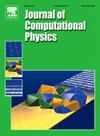一种新的运动体多相流速度重建算法
IF 3.8
2区 物理与天体物理
Q2 COMPUTER SCIENCE, INTERDISCIPLINARY APPLICATIONS
引用次数: 0
摘要
提出了一种新的速度重建方案,通过给定的速度矢量表面场,以二阶精度重建以细胞为中心的速度场,然后将其纳入高保真的数值模型中,求解非结构网格上任意拉格朗日-欧拉(ALE)公式中的不可压缩Navier-Stokes方程。与传统模型在整个区域使用传统的平衡力(CBF)算法从表面法向压力梯度重建质心速度变化不同,该模型在界面区域和非界面区域采用了两种不同的方案。在界面区域,利用通用平衡力(GBF)算法计算的表面法向压力梯度重构以胞心为中心的速度变化,抑制CBF算法在非正交网格上压力梯度与外力不平衡离散所产生的非物理流动;在非界面区域,通过对压力泊松方程的修正,获得足够精度的压力梯度矢量表面场,实现了速度变化的二阶速度重建方案。所建立的模型能够有效地抑制网格变形引起的不稳定性和流固耦合(FSI)中的非线性,并以满意的节能和较高的精度捕获流动结构。各种数值实例表明,本算法和计算框架为非结构网格上多相FSI流的流场和刚体运动提供了一个更准确、更稳健的预测平台。本文章由计算机程序翻译,如有差异,请以英文原文为准。
A new velocity reconstruction algorithm for multiphase flows with moving bodies
A new velocity reconstruction scheme is proposed to reconstruct the cell-centered velocity field with second-order accuracy through the given surface field of velocity vectors, and then incorporated into a high-fidelity numerical model to solve the incompressible Navier–Stokes equations in the arbitrary Lagrangian-Eulerian (ALE) formulation on unstructured grids. Different from the conventional model that reconstructs the centroidal velocity variation from the surface normal pressure gradients with the conventional balanced-force (CBF) algorithm in the entire domain, the present model employs two different schemes in the interface and non-interface regions. In the interface region, the cell-centered velocity variation is reconstructed with the surface normal pressure gradients calculated by the generic balanced-force (GBF) algorithm to suppress the non-physical flow generated by the imbalanced discretization between pressure gradient and external forces with CBF algorithm on non-orthogonal grids; In the non-interface region, the proposed second-order velocity reconstruction scheme for velocity variation is enabled by acquiring the surface field of pressure gradient vectors with adequate precision through the modification of pressure Poisson equation. The resulting model is able to effectively suppress the instability induced by the mesh deformation and the nonlinearity in fluid-structure interaction (FSI), and capture the flow structure with satisfactory energy conservation and higher accuracy. Various numerical examples have demonstrated that the present algorithm and computational framework offer a promising platform to provide more accurate and robust predictions of the flow field and the rigid body motion for multiphase FSI flows on unstructured grids.
求助全文
通过发布文献求助,成功后即可免费获取论文全文。
去求助
来源期刊

Journal of Computational Physics
物理-计算机:跨学科应用
CiteScore
7.60
自引率
14.60%
发文量
763
审稿时长
5.8 months
期刊介绍:
Journal of Computational Physics thoroughly treats the computational aspects of physical problems, presenting techniques for the numerical solution of mathematical equations arising in all areas of physics. The journal seeks to emphasize methods that cross disciplinary boundaries.
The Journal of Computational Physics also publishes short notes of 4 pages or less (including figures, tables, and references but excluding title pages). Letters to the Editor commenting on articles already published in this Journal will also be considered. Neither notes nor letters should have an abstract.
 求助内容:
求助内容: 应助结果提醒方式:
应助结果提醒方式:


